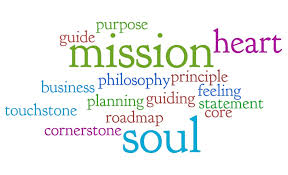A mission statement is an integral part of any organization. It is your opportunity to define the firm’s goals, values and purpose. The best mission statements explain what the organization does for its recipients, its donors, its community, and for the world.
A large majority of mission statements are laden with hollow phrases that do not adequately describe their unique organization. People often write mission statements out of obligation, failing to understand the purpose and value of a well written piece.
A mission statement, when well developed, is a formidable tool to communicate to donors and other public sector players the fundamental objectives of your organization, helping them to gain an understanding of your non-profit.
So how do you write a good mission statement?
1. Think about your story (what makes you great)
First and foremost, you need to sit down and contemplate your story. What is ‘your story’? Your story, or a market defining story, is a concise narrative that helps donors/consumers better understand your organization and its roots.
Try to answer questions like: Who is your organization? What makes you great? How do you help people and the world?
This isn’t an actual component of your mission statement, but it’s an important thing to have in your analytical arsenal while writing the mission statement. It creates context; it sits between the lines.
You don’t have to actually write out the story, but take the time to think it through. Imagine a donor making the decision of which organization they would like to donate too. Try to unpack and understand why the donor wants to donate, how they perceive your organization, and what donating to your organization will do for them. Keep your story concise, informative, and honest.
2. Reflect upon the good that you do.
It’s imperative that you think about the positive impact your organization has on the world. Your mission statement needs to describe the good work you do. You can use your market defining story to clarify which aspects of your organization make you special and exemplary for donors.
While you do not want to embellish, make sure you don’t undervalue your organization. Now is not the time to be modest. You do not have to rid the world of hunger in one fell swoop to be a reputable charity; focus on your strengths. Do you provide tampons to teenage girls in developing countries? Discuss the ripple effect that has: fewer missed school days, less shame in the community, able to help family with chores, etc.
3. Consider your overarching goal.
Think about your end goal; how do you want to better the world? This is called your vision statement. Your mission statement provides an analysis of how you will achieve this goal. There is a saying, “means to an end”. The mission statement is your means to the end goal, and the means can only be determined once you know what you want in the end.
Once you know exactly where you want your organization to go, you can then map out the path.
4. Review, cut and polish.
Editing: this may be the most important step.
Mission statements are a critical component of any organization; for-profit and non-profit. Take the time to ensure it is perfect. Edit, edit, edit.
A mission statement should be only one or two sentences. A good mission statement answers questions about your organization and defines its objectives.
While editing, watch out for the buzzwords and clichés. Cut as much as possible that is not unique to your organization. It is helpful to read mission statements from other organizations. Get a sense of what makes an effective mission statement and get inspired. Then write a great one for yourself.
Lastly, listen. Share your draft with others whose opinions you value. Ask for advice. Listen. Then edit again.
Mission statements are difficult. You are trying to convey the essence of your entire organization in only a few sentences. But if you give the task its due attention, follow these steps, and take your time, you can write a great mission statement.
Good luck and happy writing! Enjoy a few examples of mission statements from some of the top non-profit organizations in the world. (Note: notice how concise and informative they are?)

To serve individuals and families in the poorest communities in the world.
The increase and diffusion of knowledge.
To create lasting solutions to poverty, hunger, and social injustice.
To inspire and empower people affected by cancer.
To bring a permanent end to LRA atrocities.
Celebrating Animals, Confronting Cruelty.
A better world through kindness to animals.






